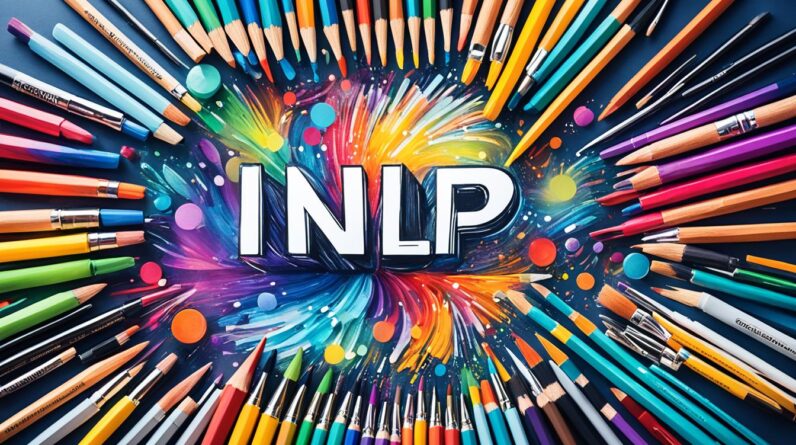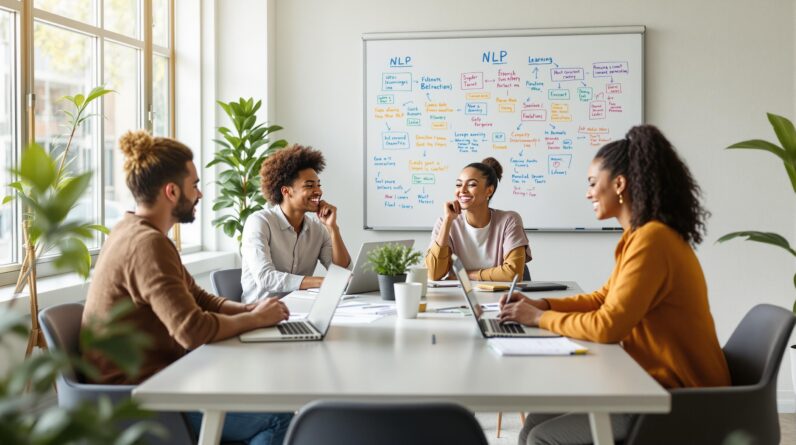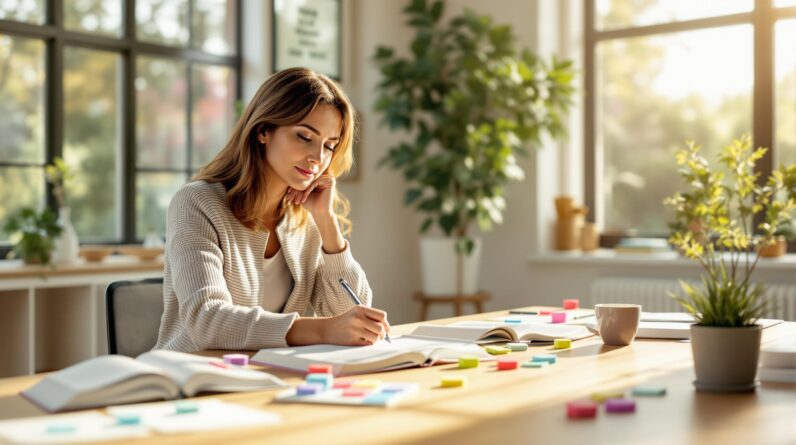
Did you know that Neuro-Linguistic Programming (NLP) can revolutionize artistic expression, boost creativity, and enhance your workflow as a creative? NLP techniques provide a powerful toolkit for unlocking your artistic potential and achieving greater levels of productivity.
Whether you’re a writer, painter, musician, or any other type of creative, incorporating NLP into your practice can lead to a profound transformation in your creative process and output. By exploring the connection between thoughts, language, and behavior, NLP helps you tap into a deeper level of inspiration and unleash your true creative abilities.
So, how can NLP empower you as a creative? Let’s delve into the world of NLP techniques and discover how they can enhance your artistic expression, boost your creativity, and elevate your productivity.
Key Takeaways:
- NLP techniques can revolutionize artistic expression and boost creativity.
- Anchoring techniques help access positive and resourceful mental states for enhanced creativity.
- Reframing techniques overcome limiting beliefs and foster a mindset of exploration.
- Visualization and guided imagery techniques stimulate imagination and inspire creativity.
- By integrating NLP into your creative process, you can unlock your artistic potential and achieve greater productivity.
Tapping into the Power of Anchoring Techniques for Creativity
Anchoring techniques in NLP offer a powerful tool for creatives to tap into their creative potential and enhance their artistic expression. By associating specific triggers with positive or resourceful mental states, anchoring allows you to access a positive mindset and boost your confidence and inspiration.
Imagine a time when you felt completely inspired and creatively alive. It could be a moment of pure joy, a breakthrough idea, or a state of complete focus. Now, by using anchoring techniques, you can recreate that state whenever you need it.
“By consistently practicing anchoring techniques, creatives can access positive or resourceful states at will and overcome creative blocks.”
When you anchor positive states, you are essentially creating a mental shortcut to access that positive mindset whenever you desire. Just like a song that instantly brings back memories or a scent that triggers emotions, anchoring allows you to tap into your most resourceful states of focus, openness, and clarity.
Here’s how you can begin practicing anchoring techniques:
- Choose a physical or mental anchor: It could be a touch on your wrist, a specific word, or even a visualization.
- Recall a moment when you were in a positive or resourceful state. Vividly remember and relive that experience.
- Anchor the state by activating the chosen physical or mental anchor exactly when you experience the positive state at its peak.
- Repeat the process multiple times, associating the anchor with the positive state each time, reinforcing the connection.
To access the anchored state, simply activate the anchor whenever you need to tap into that positive or resourceful mindset. With practice, you’ll be able to overcome creative blocks, boost your overall creativity and productivity, and achieve a state of flow in your creative endeavors.
Remember, anchoring techniques are a gateway to unlocking your creative potential and accessing the states of mind that fuel your artistic expression.
Unlocking Creativity through Reframing Techniques
Reframing, a powerful technique in Neuro-Linguistic Programming (NLP), holds the key to unlocking your creative potential. By challenging and transforming your limiting beliefs, you can break free from mental constraints and open up new possibilities for creativity.
Imagine a painter who believes they can only create realistic portraits. Through reframing, they can challenge this belief and explore abstract art or experiment with different styles. By shifting their perspective and adopting multiple viewpoints, they gain fresh insights and generate innovative ideas.
“Reframing allows you to see the world through a different lens, enabling you to approach problems and creative challenges with a new sense of curiosity and exploration.”
When faced with creative blocks, incorporating reframing techniques into your creative process can be transformative. It fosters a mindset of exploration, encouraging you to question assumptions and venture into uncharted territories. As you challenge your beliefs and shift your perspectives, you unlock your artistic talents and unleash your true creative potential.
Embracing the Power of Reframing Techniques
Here are some practical reframing techniques you can implement:
- Identify your limiting beliefs: Reflect on the beliefs that hold you back from exploring new creative horizons. Acknowledge them and understand how they shape your creative process.
- Question your beliefs: Challenge the validity of your limiting beliefs by considering alternative perspectives. Ask yourself, “What if this belief is not true?” or “How can I see this situation from a different angle?”
- Seek inspiration from others: Engage with artists from diverse backgrounds and absorb their perspectives. Surrounding yourself with different viewpoints expands your mental landscape, offering fresh inspiration for your creative endeavors.
- Experiment with different mediums: Push the boundaries of your comfort zone by trying out new mediums or artistic techniques. Embrace the opportunity to explore unexplored territories and challenge preconceived notions.
By embracing reframing techniques, you embark on a journey of self-discovery and creative exploration. You break free from the limitations that hold you back and unlock your true artistic potential.

Enhancing Inspiration and Creativity through Visualization and Guided Imagery
Visualization and guided imagery techniques are powerful tools in the realm of NLP for Creatives. They empower individuals to create vivid mental pictures of their desired creative outcomes, tapping into the immense potential of their minds. By harnessing these techniques, you can stimulate your imagination, gain clarity, and find inspiration for your artistic endeavors.
Through visualization, you can envision yourself achieving success in your creative pursuits. Imagine seeing your artwork come to life, or visualize yourself delivering an exceptional performance. By repeatedly visualizing these positive outcomes, you reinforce a positive mindset and build confidence in your abilities.
Guided imagery exercises take visualization a step further by providing structured imagery and sensory experiences. As you engage in guided imagery, you can immerse yourself in detailed mental scenarios, exploring a realm of possibilities and expanding your creative horizons. It’s a way to access new perspectives, tap into your intuition, and unlock innovative ideas.
When practicing visualization and guided imagery, it’s important to create a peaceful and focused environment. Find a quiet space where you can relax and concentrate on your mental imagery. Close your eyes, take deep breaths, and allow yourself to enter a state of calm and receptiveness.
As you progress in your visualization practice, consider incorporating various elements that engage your senses. Visualization can involve not just images but also sounds, smells, tastes, and textures. By involving multiple senses, you can enhance the richness and realism of your mental experiences, making them more impactful on your creative process.
Remember, visualization and guided imagery are not merely daydreaming; they are intentional practices that can have a profound impact on your artistic journey. By consistently integrating these techniques into your creative routine, you can tap into the depths of your creativity, find inspiration in the most unexpected places, and bring your artistic vision to life.
“Visualization is a powerful tool that allows us to tap into the creative energy within ourselves and bring our dreams to life.” – Maya Angelou
Unlocking Your Creative Potential with Visualization and Guided Imagery:
- Visualize yourself achieving your creative goals and immerse yourself in the satisfaction and joy of success.
- Focus on sensory details during visualization, engaging multiple senses to make the experience more vivid and impactful.
- Incorporate guided imagery exercises into your creative routine, exploring new scenarios and perspectives to stimulate your imagination.
- Find a quiet and peaceful space for your visualization practice, allowing yourself to relax and focus on your mental imagery.
- Consistently practice visualization to reinforce positive beliefs, boost confidence, and find ongoing inspiration in your creative pursuits.
Conclusion
Integrating NLP techniques into your creative process can have a profound impact on your artistic potential, boosting your creativity and enhancing your productivity. By harnessing the power of anchoring, reframing, visualization, and guided imagery, you can tap into your innate creative abilities, overcome limitations, and explore new horizons in your artistic expression.
NLP provides a valuable toolkit for creatives to unlock their true potential, unleash their creativity, and achieve greater levels of productivity in their creative endeavors. Through anchoring positive and resourceful states, you can access a mindset of inspiration and confidence. Reframing techniques help you challenge limiting beliefs and shift perspectives, allowing for fresh insights and innovation.
Visualization and guided imagery techniques allow you to create vivid mental pictures of your desired creative outcomes, stimulating your imagination and providing clarity and inspiration. By embracing NLP, you embark on a transformative journey of self-discovery and creative exploration, unlocking your unique artistic potential.
So, take advantage of NLP for creatives today and unlock the power within you to boost your creativity, enhance your productivity, and create art that truly resonates with your audience.







